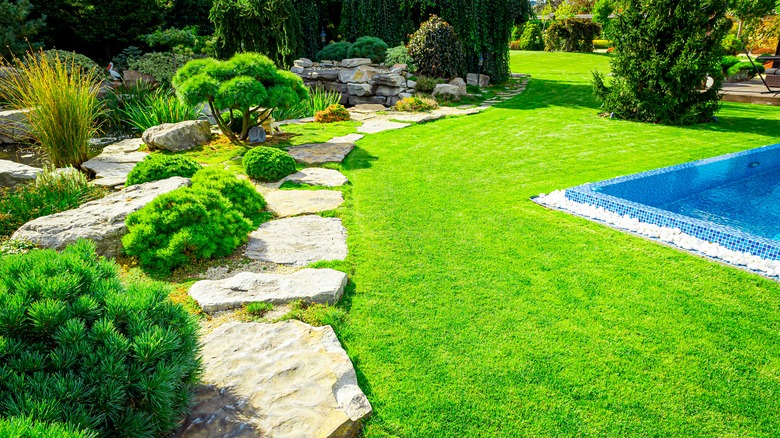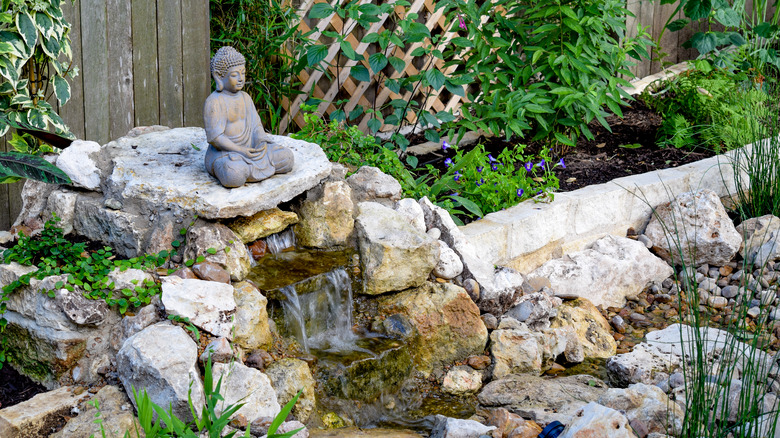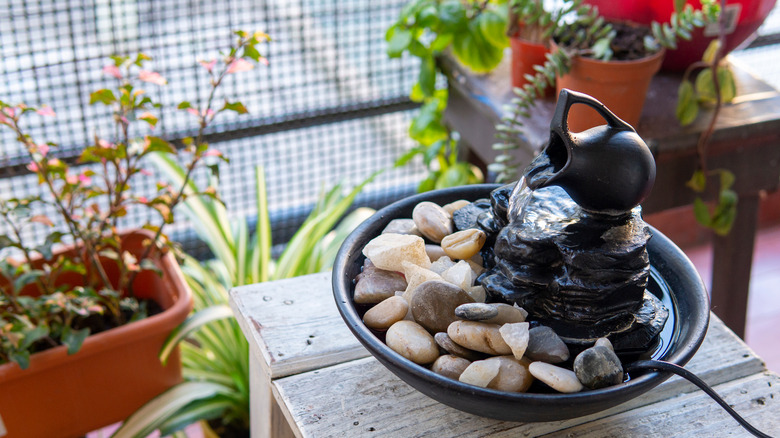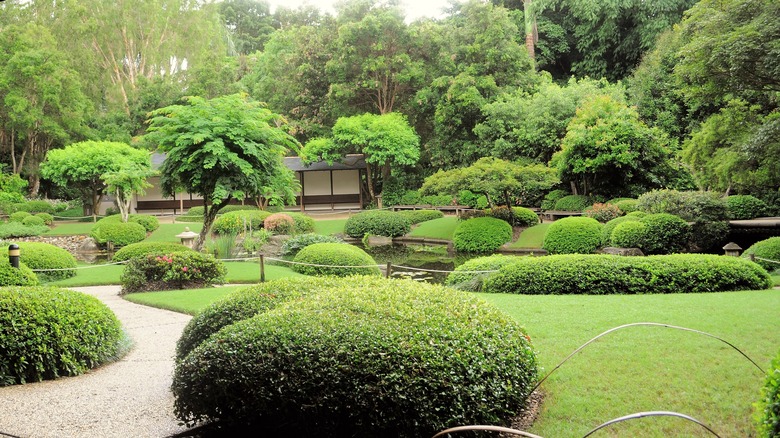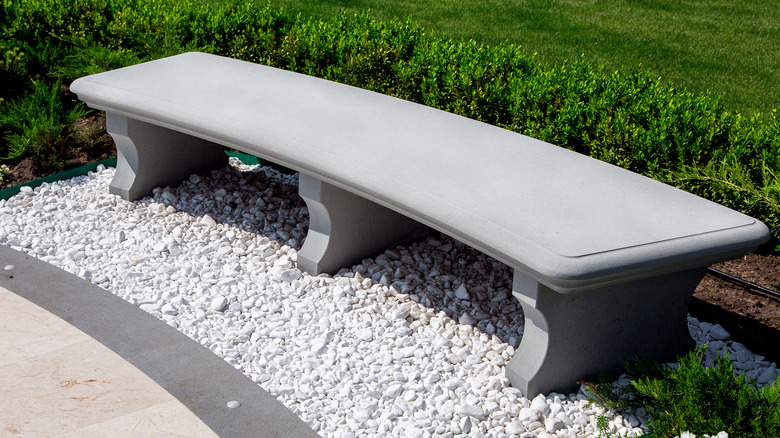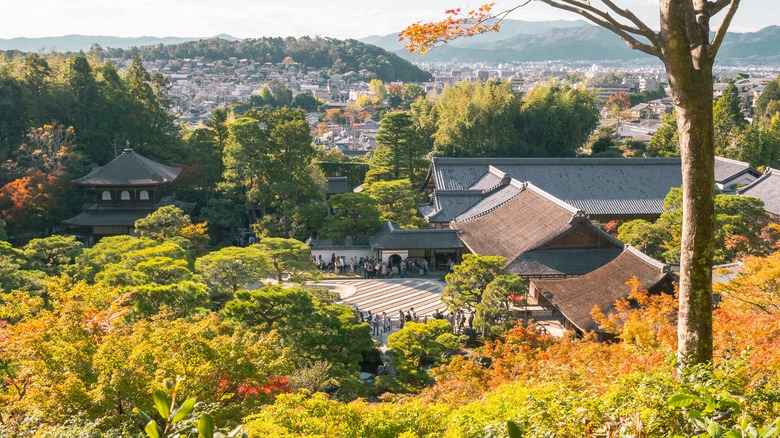Create Zen Ambience In Your Yard With These Simple Elements
Do you love zen gardens and want to bring a touch of sophistication and tranquility to your own yard without an expensive overhaul? By adding just an element or two, your landscape can be transformed without breaking your budget or a sweat. This type of design is minimalist, using mostly stone, water, and a limited variety of plants, reports NBC News.
Specifically, the key elements featured in a zen garden include: rock (ishi), water (mizu), plants (shokobutsu), bridges (hashi), borrowed view (shakkei), and decorations, such as lights and lanterns (tenkeibutsu), per Garden Beast. The idea is to use these elements to create a place of balance and serenity, a retreat from the busyness of life that focuses on the natural beauty and connectedness of the world. According to Piatra Online, to do so one must also incorporate the seven guiding principles of a zen garden, which are tranquility (seijaku), simplicity (kanso), allusion (yugen), surprise (datsuzoku), asymmetry (fukinsei), nature (shizen), and elegance (shibumi).
Before deciding on certain features, think about how you will use the garden. Next, determine how much of your yard will be dedicated to it. Any amount of space is suitable for a zen garden. Focus on the shape of the area and on creating the right vibe since it's intended to be a place for meditation, mindfulness, and relaxation. Traditionally, a fence was used to differentiate this area from the rest of the terrain, but many modern zen gardens break the rules to allow for more personalization.
Stone features are fundamental
Rocks are integral in Japanese style gardens and used to represent many things such as mountains, animals, fire, and even the Buddha. Poised at an entryway, they welcome visitors into the space. Smaller stones are situated throughout as stepping stones, neatly raked gravel or pebbles, and stacks of flat stones. Each application is visually appealing and placed in a manner that embraces order and open space, indicating something in nature to be viewed and, more importantly, reflected upon, says The Collection by BBC.
Incorporate stone into your garden with the positive energy of Buddha statues, which come in a variety of poses and postures that represent the spiritual teacher's travels and teachings. Learn Religions says that each statue's symbolic hand gesture (mudra) has a specific, powerful meaning. The four Buddha poses are sitting (meditating), followed by standing (teaching), walking (journey), and reclining (reaching nirvana). Historically, Buddha statues were made of stone, but modern options include lightweight materials as well.
The use of gravel – specifically pea gravel or a traditional Japanese mix called shirakawa – represents tranquility. White sand is also extremely popular and versatile in zen garden design. Stepping stones influence mindfulness. As Japan is mountainous, they are a reminder of this terrain and the importance of careful treading. Stepping stones help to clear yard clutter by creating a disciplined path on which to focus and help to guide visitors through the garden.
Water brings renewal and calm
Just as water physically follows the path of least resistance, its gentle beckoning of soft sounds finds its way into our psyche and helps transport us to a place of relaxation and reflection, which is why water features are a perfect addition to zen gardens. Not all designs feature water; those that don't are called dry gardens and tend to use sand to represent water. Adding this element to your design can be as simple as a small water fountain or as elaborate as a large pond or waterfall. Koi ponds are attractive and popular, but require a bigger budget.
Surrounding a water feature with sand, pebbles, or rocks is an ideal way to bring in other important elements. A traditional Japanese bridge ties in beautifully, if your space and budget can allow for one. Functional and symbolic, bridges represent the journey or transcendence from this physical world into the next spiritual plane or afterlife, according to Big Blog of Gardening. Although water and bridges go well together, oftentimes a bridge is designed to span over dry rocks or hills. Both features add interest and elegance to the space.
Trees and plants bring softness and contradiction
The palette of a traditional zen garden consists of minimal muted colors. Plants, trees, and shrubs subscribe to this very disciplined approach to create an orderly, pruned environment while also adding beauty. Depending on their placement, plants can represent other things in nature such as islands.
Common plants for such purposes are non-invasive bamboo, cherry trees, evergreens, ornamental grasses, camellia, azalea, and Japanese maple. Pine and flowering plum trees are also popular choices. North Carolina Extension says that trees and plants hold a lot of symbolism in a zen garden. Trees represent longevity and resilience through weathering adversity, while delicate blossoms grow in contrast to the highly manicured nature of the garden. Moss is another excellent addition as it covers the ground between stepping stones and pathways effortlessly.
Traditionally, flowers were sparsely used, if at all, in Japanese gardens. Plants were selected in various shades of green to promote harmony and complement the inorganic hardscape materials. Modern zen gardens have become more personalized with dots of color and charming blooms, but keeping the color scheme simple is still ideal.
Ornamentation creates personalization and excitement
Modest decoration in a zen garden can create a warm and welcoming space. Statues of the Buddha or meditating monks, and items found in nature are perfect examples of things that add interest. And who doesn't love the soft glow of a lantern or a simple string of lights? Lighting should be strategic and purposeful rather than distracting. Another great way to illuminate the garden is to place lights low to the ground that accentuate paths or stone areas.
Seating is also an important feature that can allow for personalization. Benches made of natural materials and large, flat rocks are ideal, but choosing a special chair can add a personal touch. The seating should be placed in a spot that allows for gazing and quiet reflection.
Design Solid recommends also adding archways, gates, and water basins to your design, as they can offer both function and beauty. Pergolas and small buildings are common features as well.
Instill harmony with a borrowed view
A zen garden is a retreat from the urgency of the modern world, but to exhibit harmony and balance while enhancing the aesthetics of the space, it's common to incorporate the landscape that's beyond the garden border. For example, if you live in a city with tall buildings, designing with those views in mind as an element of your garden can have a wonderful impact. Another way to borrow a view is to frame within the gazing area of your garden the hills, trees, mountains, or other natural elements in the distance. Garden Beast explains that this practice honors existing nature and the world around us.
Borrowing scenery and instilling the view within your design is a way to encourage connectedness. Rather than shutting out the rest of the world or trying to change it, it is celebrated as a seamless part of the garden. By using this practice, regardless of where you live, you can create your own zen oasis.
